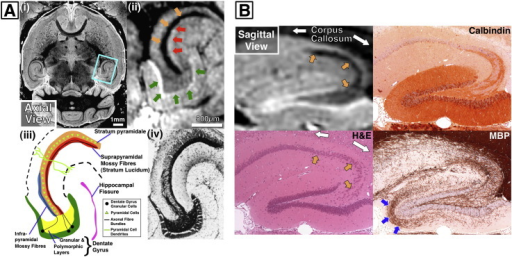

Pyramidal cells of CA3 send their axons to CA1. Granule cells of the DG send their axons (called "mossy fibers") to CA3. There is also a distinct pathway from layer 3 of the EC directly to CA1, often referred to as the temporoammonic or TA-CA1 pathway. These axons arise from layer 2 of the entorhinal cortex (EC), and terminate in the dentate gyrus and CA3. Most external input comes from the adjoining entorhinal cortex, via the axons of the so-called perforant path. The major signaling pathways flow through the hippocampus and combine to form a loop. To refer to the hippocampus proper plus dentate gyrus and subiculum. Use the term "hippocampus proper" to refer to the four CA fields, and hippocampal formation Transition to the cortex proper (mostly the entorhinal area of the cortex). After this comes a pair of ill-defined areas called the presubiculum and parasubiculum, then a After CA1 comes an area called the subiculum. The CA areas are all filled with densely packed Pyramidal cells similar to those found in the neocortex. NextĬome a series of Cornu Ammonis areas: first CA4 (which underlies the dentate gyrus), then CA3, thenĪ very small zone called CA2, then CA1. Structure, a tightly packed layer of small granule cells wrapped around the end of the hippocampus proper, forming a pointed wedge in some cross-sections, a semicircle in others.

The first of these, the dentate gyrus (DG), is actually a separate Starting at the dentate gyrus and working inward along the S-curve of the hippocampus means traversing a Neuroimaging pictures can show a number of different shapes, depending on the angle and location of the cut.īasic circuit of the hippocampus, shown using a modified drawing by Ramon y Cajal. Due to the three-dimensional curvature of this structure, two-dimensional sections such as shown are commonly seen. In primate brains, including humans, the portion of the hippocampus near the base of the temporal lobe is much broader than the part at the top. For example, in the rat, the two hippocampi look similar to a pair of bananas, joined at the stems. This general layout holds across the full range of mammalian species, from hedgehog to human, although the details vary. It has a distinctive, curved shape that has been likened to the sea-horse monster of Greek mythology and the ram's horns of Amun in Egyptian mythology. Hippocampus anatomy describes the physical aspects and properties of the hippocampus, a neural structure in the medial temporal lobe of the brain. Nissl-stained coronal section of the brain of a macaque monkey, showing hippocampus (circled).


 0 kommentar(er)
0 kommentar(er)
